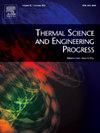不可逆吸收式蓄能供热系统热力优化及3E性能分析
IF 5.1
3区 工程技术
Q2 ENERGY & FUELS
引用次数: 0
摘要
研究了基于有限时间热力学的吸收式储能系统的性能。考虑系统的不可逆性、蓄能与释放时间比、热阻和热泄漏,建立了系统的热力学模型。研究的重点是三个评价标准:基于火用的生态标准(E)、火用性能标准(EPC)和热经济标准(k2f)。系统地分析和讨论了不可逆性因素、能量储存和释放时间比、热泄漏、热经济参数、热源温度和传热系数对这些准则的影响。此外,改进系统性能的方法也进行了全面的研究。结果表明,相对于最大放热速率点,最大k2f准则点和最大E准则点可以显著提高储能效率,但会降低一定的放热速率。增加系统的不可逆性因子和时间比可以显著提高ESE和k2f准则,但代价是生态性能和放热能力的降低。虽然热源温度对k2f准则的影响可以忽略不计,但提高吸收体热源温度可显著提高E准则。另外,将储热罐的换热系数提高0.4 kW/(K·m2),可使E准则函数的最大值提高8.6%,使系统放热率上限提高65.1%。这些发现为AES系统的设计提供了理论见解。本文章由计算机程序翻译,如有差异,请以英文原文为准。
Thermodynamic optimization and analysis of 3E performance for irreversible absorption energy storage heating system
This study analyzes the performance of an absorption energy storage (AES) system based on finite-time thermodynamics. A thermodynamic model of the system is established by accounting for system irreversibility, energy storage and release time ratio, thermal resistance, and heat leakage. The study focuses on three evaluation criteria: the exergy-based ecological criterion (E), the exergetic performance criterion (EPC), and the thermo-economic criterion (k2f). The effects of irreversibility factors, energy storage and release time ratio, heat leakage, thermo-economic parameter, heat source temperature, and heat transfer coefficients on these criteria are systematically analyzed and discussed. Additionally, methods for improving system performance are thoroughly examined. The results indicate that relative to the maximum heat release rate point, the maximum k2f criterion point and the maximum E criterion point can significantly enhance energy storage efficiency (ESE) at the cost of a certain reduction in heat release rate. Increasing the system’s irreversibility factor and time ratio can substantially improve ESE and k2f criterion, albeit at the expense of ecological performance and a decrease in heat release capacity. Although the heat source temperature has a negligible effect on k2f criterion, increasing the absorber heat source temperature significantly enhances the E criterion. Moreover, raising the heat transfer coefficient of the energy storage tank by 0.4 kW/(K·m2) increases the maximum value of the E criterion function by 8.6 % and expands the upper bound of the system’s heat release rate by 65.1 %. These findings offer theoretical insights for the design of AES systems.
求助全文
通过发布文献求助,成功后即可免费获取论文全文。
去求助
来源期刊

Thermal Science and Engineering Progress
Chemical Engineering-Fluid Flow and Transfer Processes
CiteScore
7.20
自引率
10.40%
发文量
327
审稿时长
41 days
期刊介绍:
Thermal Science and Engineering Progress (TSEP) publishes original, high-quality research articles that span activities ranging from fundamental scientific research and discussion of the more controversial thermodynamic theories, to developments in thermal engineering that are in many instances examples of the way scientists and engineers are addressing the challenges facing a growing population – smart cities and global warming – maximising thermodynamic efficiencies and minimising all heat losses. It is intended that these will be of current relevance and interest to industry, academia and other practitioners. It is evident that many specialised journals in thermal and, to some extent, in fluid disciplines tend to focus on topics that can be classified as fundamental in nature, or are ‘applied’ and near-market. Thermal Science and Engineering Progress will bridge the gap between these two areas, allowing authors to make an easy choice, should they or a journal editor feel that their papers are ‘out of scope’ when considering other journals. The range of topics covered by Thermal Science and Engineering Progress addresses the rapid rate of development being made in thermal transfer processes as they affect traditional fields, and important growth in the topical research areas of aerospace, thermal biological and medical systems, electronics and nano-technologies, renewable energy systems, food production (including agriculture), and the need to minimise man-made thermal impacts on climate change. Review articles on appropriate topics for TSEP are encouraged, although until TSEP is fully established, these will be limited in number. Before submitting such articles, please contact one of the Editors, or a member of the Editorial Advisory Board with an outline of your proposal and your expertise in the area of your review.
 求助内容:
求助内容: 应助结果提醒方式:
应助结果提醒方式:


